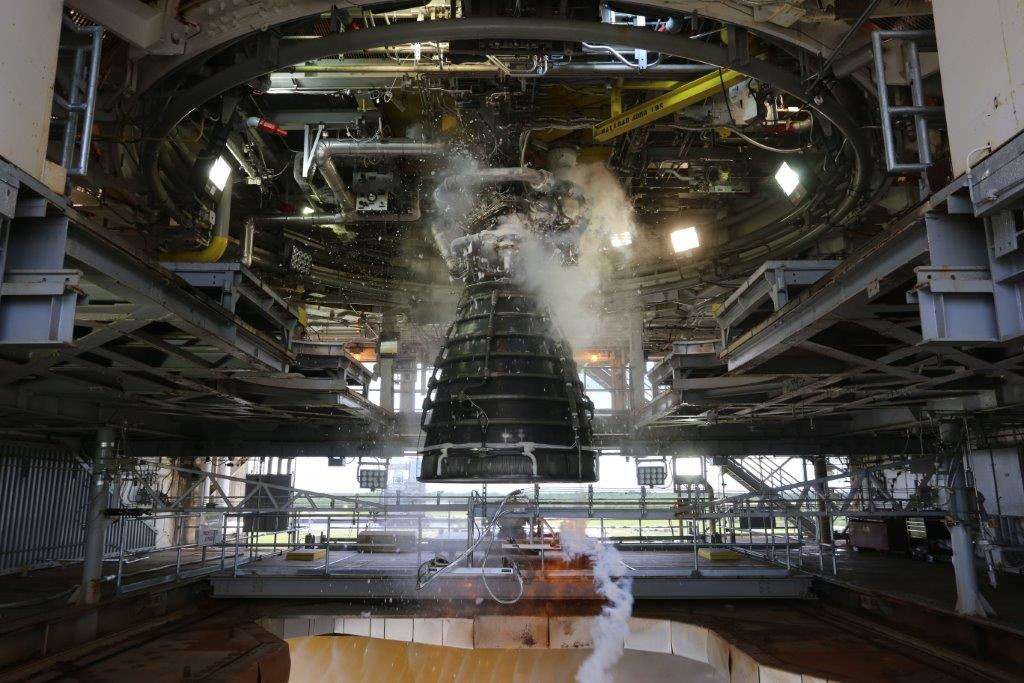Engine for DARPA's New Military Space Plane Aces Record-Breaking Test
The company Aerojet Rocketdyne has successfully wrapped up a marathon test of the space shuttle-era AR-22 engine, firing it 10 times in 10 days to test its suitability for a quick-turnaround reusable space plane.
The engine test, undertaken at NASA's Stennis Space Center in Mississippi, is the latest step in the U.S. Defense Advanced Research Projects Agency's (DARPA) Experimental Spaceplane program. The crew worked 24/7 to fuel and fire the massive engine 10 times, for 100 seconds each, over 10 days — ending with 68 minutes to spare, and even enduring two lightning strikes to the building housing the test.
"We completely destroyed previously held records [for] a liquid hydrogen/liquid oxygen-type engine," Scott Wierzbanowski, DARPA's Experimental Spaceplane program manager, said during a teleconference with reporters today (July 10). "And we shattered this idea that these types of engines can't be used in a very operable and aircraft-like way." [DARPA's Experimental XS-1 Space Plane in Pictures]

DARPA selected Boeing to build a reusable space plane, called Phantom Express, propelled upward with Aerojet Rocketdyne's engine — a version of which was the space shuttle's main engine. Before this, that engine had only been re-fired within 24 hours once before.
This test helps validate the idea of a reusable spacecraft with a quick turnaround that’s closer to that of an aircraft, officials said during today's discussion. Phantom Express is designed to launch vertically, releasing a disposable second stage at between 200,000 and 300,000 feet (60,000 to 90,000 meters) to deploy a satellite into orbit, Wierzbanowski said, before the space plane glides to the ground for a smooth landing. It should be able to release more than 3,000 lbs. (1,360 kilograms) into orbit for a cost of less than $5 million per flight — and the first test flight of the system is currently set for 2021.
Every day during the 10 engine firings, workers delivered 300,000 lbs. (136,000 kg) of propellant on barges to the test facility. After the engine was dried from its previous firing — an interval that the company shrank from 17 hours at first to 6 hours at one point, representatives said — the workers conducted detailed hardware inspections close to midnight and loaded in the propellant starting at 7 a.m.
"Going into the test, we thought the engine would be technically challenging to get through this, and we were expecting to have to overcome some of the challenges there, but really, the engine performed flawlessly — we didn't have any issues with it," said Jeff Haynes, Aerojet Rocketdyne's AR-22 program manager.
Get the Space.com Newsletter
Breaking space news, the latest updates on rocket launches, skywatching events and more!
But it wasn't entirely smooth sailing: "We did have Mother Nature intervene on a couple of occasions where we actually had two very direct lightning strikes to the test facility — that resulted in some level of damage to the facility that we had to scramble and repair to stay on track to complete the test series," Haynes said. "Which we did. And that's really a testament to the blended team approach we had; with NASA, the S3 contractor, DARPA, Boeing and Aerojet Rocketdyne all pulling together with two 12-hour shifts round the clock 24/7 to get this done."
According to Steve Johnston, the launch director for Boeing’s Phantom Express, the flight hardware construction is happening simultaneously with the engine tests; the last subsystem review is in February of 2019, and then assembly can begin, aiming for that 2021 test flight. The design guidelines and philosophies for the spacecraft are drawn from commercial airlines, he said during the roundtable.
"Aerojet Rocketdyne has continued to refine the reusable engine technology we originally developed for the space shuttle program," Eileen Drake, Aerojet Rocketdyne CEO and president, said in a statement. "With the AR-22, we are taking reusability to the next level and have demonstrated that daily, affordable access to space is within reach."
Email Sarah Lewin at slewin@space.com or follow her @SarahExplains. Follow us @Spacedotcom, Facebook and Google+. Original article on Space.com.
Join our Space Forums to keep talking space on the latest missions, night sky and more! And if you have a news tip, correction or comment, let us know at: community@space.com.

Sarah Lewin started writing for Space.com in June of 2015 as a Staff Writer and became Associate Editor in 2019 . Her work has been featured by Scientific American, IEEE Spectrum, Quanta Magazine, Wired, The Scientist, Science Friday and WGBH's Inside NOVA. Sarah has an MA from NYU's Science, Health and Environmental Reporting Program and an AB in mathematics from Brown University. When not writing, reading or thinking about space, Sarah enjoys musical theatre and mathematical papercraft. She is currently Assistant News Editor at Scientific American. You can follow her on Twitter @SarahExplains.









